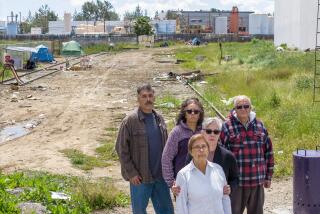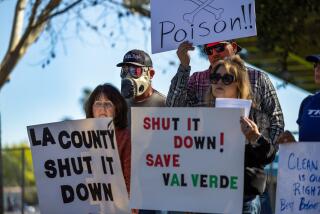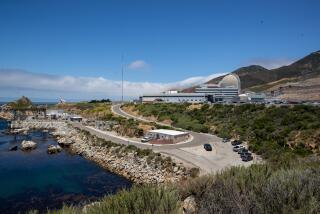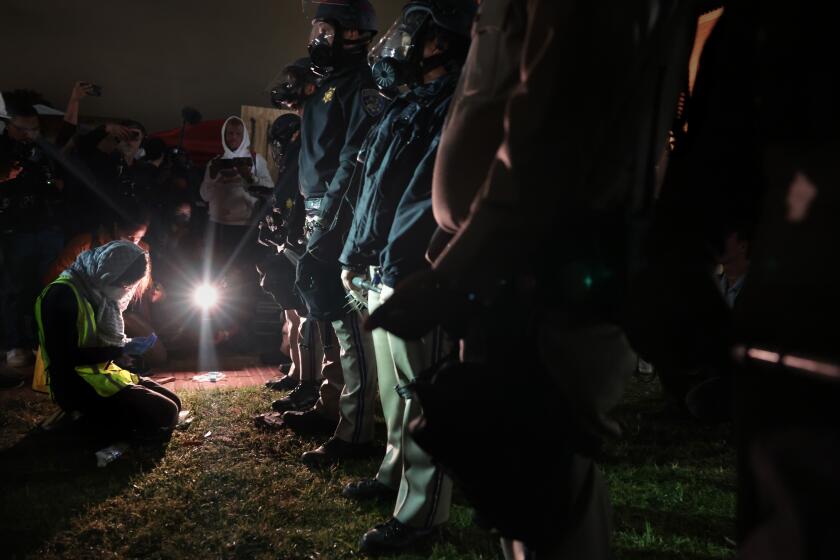Final canister of nuclear waste transferred to storage facility at San Onofre
It took 32 months, but the transfer of dozens of canisters filled with nuclear waste from wet storage pools to a newly constructed dry storage facility at the San Onofre Nuclear Generating Station wrapped up Friday.
Shortly before 5 a.m., workers lowered the 73rd and final canister of spent radioactive fuel into its assigned enclosure at the north end of the plant, known as SONGS.
At commercial nuclear plants, after radioactive fuel used to generate electricity loses its effectiveness, it is placed in metal racks that are stored in cooling pools, typically for about five years. Once cooled, the fuel can be transferred to a dry storage facility, which is generally considered a safer place for it.
Officials at Southern California Edison, the operator at SONGS, said completing the transfers is a key part of the company’s eight-year plan to dismantle most of the structures at the plant, which has not produced power since 2012 and is being decommissioned.
“The safe completion of this storage campaign ... ends the largest canister loading campaign ever in the U.S.,” Vince Bilovsky, Edison’s deputy decommissioning officer, said in an email. “But our work won’t truly be done until all canisters at SONGS are relocated off-site to a federally licensed storage or disposal facility.”
Longtime critics of Edison were not cheering the news.
“It’s a sad day,” said Ray Lutz, national coordinator for the advocacy group Citizens’ Oversight. “People say, well, [the waste issue] is fine right now, and we’ll deal with it later. But this is what they’ve said ever since they started this nuclear industry: ‘We’ll figure it out later,’ the five favorite words.”
Transfer operations at SONGS began in January 2018 and have not been entirely smooth. That summer, one of the 50-ton canisters became misaligned during handling and was left perched on the rim of its cavity, 20 feet off the ground, without support, for 45 minutes.
The U.S. Nuclear Regulatory Commission, after a special inspection, fined Edison $116,000, and the energy company and its chief contractor, Holtec International, suspended all transfers for 11 months while it revised procedures.
Since then, 44 canisters have been transferred at SONGS. Another 50 canisters sit in a separate dry storage facility nearby. All told, there are 3.55 million pounds of spent fuel at the plant, which is located between San Onofre Beach and Interstate 5.
As thorny as the transfer operations were, a more complicated issue remains: how long the canisters will stay there.
SONGS is not unique. About 80,000 metric tons of waste from commercial nuclear plants are stored across the country — at 121 sites in 35 states — because the federal government has not constructed a repository to store any of it.
“Our commitment remains ensuring spent nuclear fuel is safely stored and that it can be transported to an off-site facility in the future,” Doug Bauder, Edison’s chief nuclear officer, said in a statement.
About $15 billion has been spent to construct the Yucca Mountain nuclear-waste storage site in the Nevada desert, but shortly before it was scheduled to open, the Obama administration cut off funding, heeding calls from then-Senate Majority Leader Harry Reid (D-Nev.) and other elected state officials opposed to the facility.
Some in Congress have called for reopening Yucca, and the Trump administration had proposed spending $120 million to look into re-licensing the site. But President Trump earlier this year reversed course, tweeting, “Nevada, I hear you on Yucca Mountain.”
In recent years, discussion has turned to finding alternate, “interim” sites to store waste from nuclear plants.
A spending package recently passed by the House of Representatives included $27.5 million to develop a “robust” interim storage program. Rep. Mike Levin (D-San Juan Capistrano) has called for establishing a set of federal guidelines that would put waste at sites like San Onofre — those that are near large populations and in areas with earthquake hazards — at the top of the list once a storage facility becomes available.
Two private companies have applied to build interim facilities, but whether those sites will be constructed is an open question.
Following an out-of-court settlement, Edison created a panel of experts to look at destinations for SONGS waste. Early next year, Edison intends to release a strategic plan for possible storage sites “as well as make sure that our fuel is ready for pickup when the opportunity presents itself,” Bauder said.
When the eight-year dismantlement effort at SONGS is complete, all that will remain will be the dry storage sites, a security building with personnel to look over the waste, a 28-foot seawall, a walkway connecting beaches north and south of the plant and a switchyard with power lines.
The plant’s distinctive 200-foot-high twin domes, which loom over Interstate 5, are scheduled to come down between late 2025 and 2027.
Nikolewski writes for the San Diego Union-Tribune.
More to Read
Start your day right
Sign up for Essential California for news, features and recommendations from the L.A. Times and beyond in your inbox six days a week.
You may occasionally receive promotional content from the Los Angeles Times.






